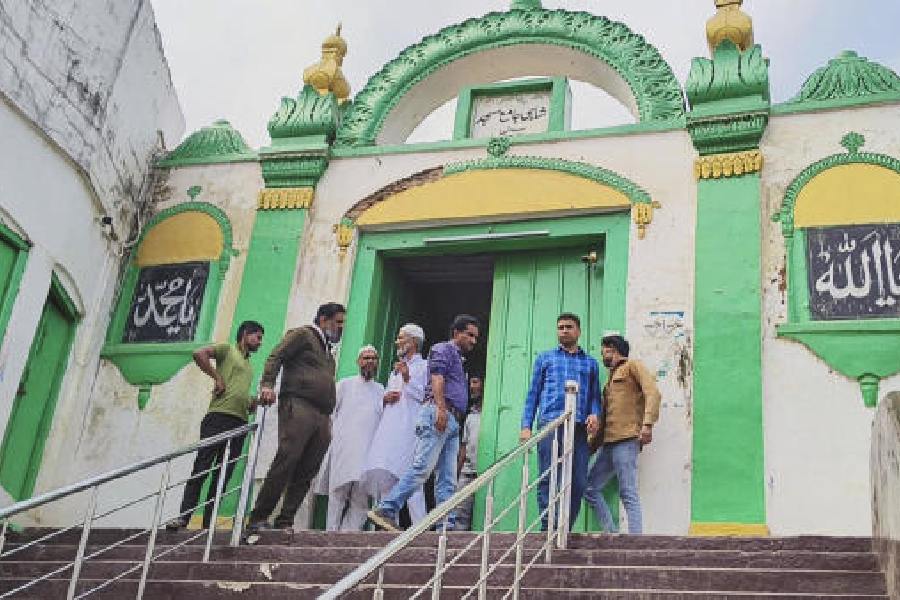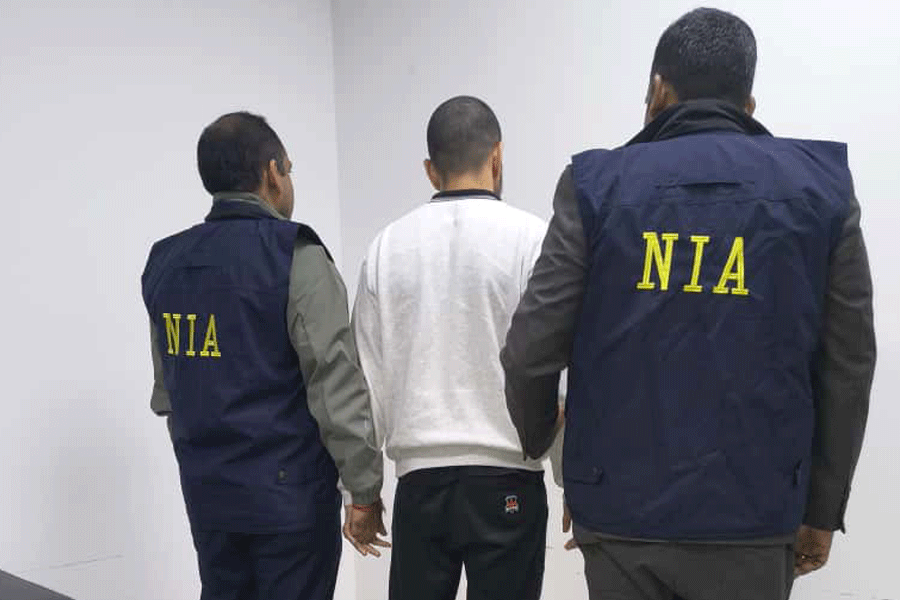What does a 13-year-old make of the words ‘Deewaaron se milkar rona achha lagta hai’ that the song becomes almost an obsession with him? Or for that matter ‘Jheel mein chaand nazar aaye’.
I was 13 when I first heard these songs on TV, in a programme where the evergreen, ever-smiling Tabassum was in conversation with this soft-spoken, unassuming young man draped in a shawl. The image is embedded in my mind over 40 years later. But what is entrenched deeper is the voice — soft, sweet, vulnerable — and the renditions of the two songs. Long before playing a song ‘on a loop’ entered our vocabulary and became a fad – it was rather cumbersome, if not impossible, to play songs on loop on tape – I was playing these on loop. Being 13 was special, a time of endless joys, friends and in the bracing cold of Shillong, one desired little else from life. There was no reason for me to cry putting my head against a wall, or be flustered about anyone wanting to see the moon reflected in the lake. Yet, the songs and the voice made a big impact, one that would flower about a decade later.
That evening marked my introduction to Pankaj Udhas. And to ghazals. At 13, my exposure to music was limited to Hindi film songs, primarily Kishore Kumar, and those staple of all Bengali households: Rabindrasangeet and Nazrulgeeti. At that age, I was not aware of Jagjit Singh, let alone Begum Akhtar, Mehdi Hasan or Ghulam Ali (who would become a rage with ‘Chupke chupke raat din’ in Nikaah a year later), or for that matter, stalwarts like Faiz Ahmed Faiz, Ahmed Faraz or the other greats.
Looking back, in many ways Pankaj Udhas was just about the perfect introduction to ghazals I could hope for. For one, the ghazals he chose to render lacked the intricacies of the classical exponents of the form, like Mirza Ghalib and Faiz. And I do not mean the lack in a disrespectful sense. They adhered to the requirements of the ghazal — the matla’a, the radeef, the aaafiya — in most cases, though at that age those considerations mattered little. What mattered was what the songs made me feel. After all, no matla’a — even if a 13-year-old had no reason to cry against the wall! — could be as evocative as:
Deewaron se milkar rona achcha lagta hai
Hum bhi paagal ho jayenge, aisa lagta hai
Or no sher, in the same ghazal by Qaiser-ul-Jafri, as beautifully expressive of the essential solitude of man:
Kitne dinon ke pyase honge yaaron socho to
Shabnam ka katra bhi jinko dariya lagta hai
It was possible to get a sense of the imagery of the ghazal and the feelings behind the words without having to resort to a dictionary. Many years later, as I moved on to Faiz and Ghalib and Mehdi Hasan and Begum Akhtar, I remember listening to the following lines by Faiz:
Gulon mein rang bhare baad-e-naubahar chalein
Chale bhi aao ke gulshan ka karobaar chalein…
Kafas udaas hai yaaro saba se kuchh toh kaho
Kahin toh bahr-e-khuda aaj zikr-e-yaar chalein
I was mesmerised by Mehdi Hasan’s rendition, the composition, and the feel of the words, but there were at least six words in those two shers that I could not understand. I did go out and buy an Urdu-English dictionary and pieced together the meaning.
However, had it not been for Pankaj Udhas preparing me a decade before that with the ghazals of Mumtaz Rashid, Sheikh Adam Abuwala, Zafar Goarakhpuri, Sardar Anjum, Qaiser-ul-Jafri and the others he brought to the limelight, I would probably not have moved on to Ghalib and Faiz. With their unpretentious approach to the ghazal, the simplicity of the words accentuating the emotions they conveyed, they made the form accessible to a novitiate like me.
Between 1981 and 1985, Pankaj Udhas published eight albums, of which two — Mukarrar and Nayaab – are among the best-ever collections of ghazals I have come across, irrespective of all the other stalwarts I have listened to. Albums often come with a flip side, a couple of songs that do not measure up to the rest. However, Mukarrar and Nayaab are rare exceptions where not a single song could be faulted. Each was exceptional, bringing together in one exhilarating cocktail the depth of the words, the hummability of the composition and, above all, the ‘voice’ rendering them. And in an era when Hindi film music was beginning to falter, Pankaj Udhas was in the right place at the right time with the right kind of music, along with Anup Jalota and his bhajans.
At the end of the day, it was the voice that made those songs what they were. There was a certain vulnerability to the way Pankaj Udhas sang that touched a chord. And though I had no one else to compare him to — barring Kishore Kumar, Hemanta Kumar and Manna Dey, and none of them sang ghazals — I knew instinctively that this is what ‘soulful’ and ‘mellifluous’ meant when it came to a voice.
When he sang ‘Tu paas hain to dil ka ajab haal sa lage… mere nahin to apne hi baare mein baat kar, khamosh tu rahe to bahut faasla lage’ (Nayaab, Mumtaz Rashid), my young heart could actually visualise the beloved sitting silently next to me. Similarly, just listen to this ghazal, again by Mumtaz Rashid in Nayaab, and you might realise why at the age of 16, they seemed just what you would like to serenade your beloved with:
Aaj wohi geeton ki rani, aaj wohi hain jaan-e-ghazal
Chalte chalte raah mein jiska, saath huaa tha pal do pal…
Manzil ke badle paaunga, kuchh yaade aur kuchh aansu
Mujhko ye maalum hain lekin, saath mere kuchh door to chal
Few singers would have been able to give a song the plangent sorrow that he imbued ‘Chand chamka hai chandni ke liye’ (Mukarrar, Sheikh Adam Abuwala). When he renders the second line of this ghazal’s matla’a, ‘Yeh bhi jeena hua kisi ke liye’, you actually feel the futility of living for someone who does not even acknowledge your presence. And the way the singer renders its makta, ‘mere dushman hi jaante hai ye, kitna tarsa hoon dosti ke liye’, you are again transported to the eternal loneliness we are condemned to and that unquenchable thirst for a friend. Or the sheer romanticism of ‘Aap jinke kareeb hote hai, woh bade khush naseeb hote hai’ (Tarannum, Nooh Narvi), which excited the romantic yearnings of many a teenager of the era.
Song after song in Mukarrar and Nayaab have this iridescent quality in them thanks primarily to the way Pankaj Udhas articulates each word, each syllable. Consider ‘Khud ki khatir na zaman eke liye zinda hoon’ (Mukarrar). Not only does poet Qamar Iqbal come up with some scintillating imagery, but the way Pankaj Udhas renders the ghazal’s makta (‘I live only to keep the messiah alive’) can only make you hold your breath:
Log jeene ke garazmand bahut hai lekin
Main masiha ko bachane ke liye zinda hu
Though in later years, his ghazals would go down the slippery maikhana and sharabi slope too often, becoming banal and losing their poetic bearings, more guzzle than ghazal, in this phase in the early 1980s even the light songs he rendered were quite irresistible: ‘Choom kar madhbhari aankhon se’, ‘Ek taraf uska ghar’, ‘Chandi jaisa rang hai tera’, ‘Niklo na benaqaab’ and ‘Sabko maloom hai main sharaabi nahin’, among others. For a period in this era, Hindi film music, always the staple music consumption of the hoi polloi, took a back seat and the ghazal and sugam-sangeet of Pankaj Udhas ruled the waves.
He may have lacked the baritone of a Jagjit Singh, the harkat of a Mehdi Hasan or a Ghualm Ali — and all this is knowledge in hindsight — but he brought a certain freshness to the ghazal and more importantly chose songs that were easy to hum and sing along in contrast to the traditional classical singing style. His compositions were breezy and smooth, soothing the senses, very different from traditional ghazals. His choice of instrumentation revolutionised the way ghazals were traditionally presented. Add to that the excellent audio presentation by Music India, with stereophonic sound.
In the mid-1980s, Pankaj Udhas became a hugely popular singer in cinema with the chartbusting ‘Chitthi aayi hai’ in Naam. The emotional response to the song has transcended generations. Anand Bakshi’s lyrics found the perfect match in Pankaj Udhas’s heart-rending vocals. So popular was the song that for probably the only time in the history of Hindi cinema, a film’s poster carried the images of its stars, Sanjay Dutt and Kumar Gaurav, along with that of the singer, the latter bigger and more prominent. Its success led to a trail of other chartbusters like ‘Jeeyen toh jeeyen kaise’ (Saajan), ‘Aaj phir tum pe pyaar aya hai’ (Daayavan), but I never took to the artifice of those songs. They left me cold.
Years later, my father bought me a four-cassette set titled ‘Ghazals from Pakistan’. It opened a new vista in my love for music in general and the ghazal in particular. As mentioned, the songs in these cassettes necessitated buying a dictionary. And the only reason I made that effort in the first place was because Pankaj Udhas and his voice had introduced me to this genre of music. None of his latter-day albums had the mesmerising quality of Mukarrar and Nayaab, though Yaara (composed by Ustad Amjad Ali Khan, with lyrics by Madan Gopal Singh) reached for that brilliance.
I met the singer a couple of weeks before the pandemic broke in 2020. He wanted to publish his memoirs and we discussed that. It was a fanboy moment. I was reminded once again that we never quite get over what we love at 14. The world of music has changed beyond recognition in the years since I was first enamoured of the voice of Pankaj Udhas. However, ‘deewaron se milkar rona’ aaj bhi achha lagta hai.
(Shantanu Ray Chaudhuri is a film and music buff, editor, publisher, film critic and writer)










